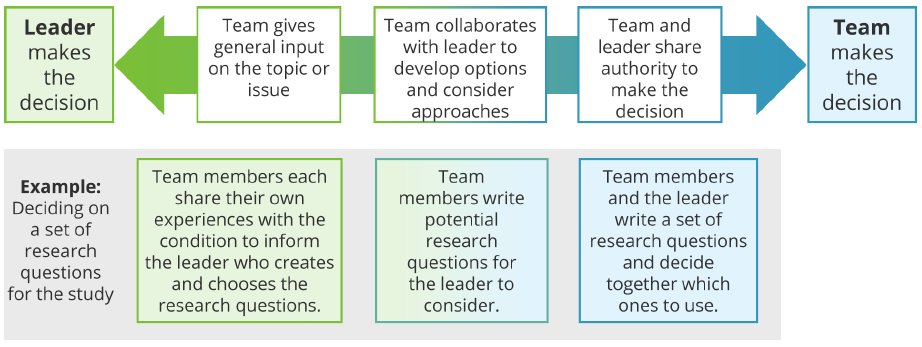Making Decisions as a Multi-Stakeholder Team
Every patient-centered outcomes research (PCOR) study involves hundreds of decisions. Working together as a team to make decisions ensures that decisions reflect the perspectives and experiences of multiple stakeholders, which can help teams conduct the study effectively and find relevant results. Team decisions take place along a continuum (see the figure below).
Continuum of Team Decision Making

With some of the decisions that the team needs to make, the leader may not be the principal investigator of the study. Rather, the leader may be anyone on the team taking leadership on a specific study task or the leader of a specific subcommittee.
Teams should work together to determine the appropriate level of stakeholder involvement for each study decision. This collaboration will give all team members clear expectations about how the team will make decisions throughout the study. When the leader makes the decision after input or collaboration, the leader should explain the decision and factors that went into it.
The Heart of All Decision Making: Productive Discussion
Productive discussion is central to the decision-making process. Productive discussion occurs when:
- Everyone affected by the decision is part of the discussion, either in person or virtually.
- Everyone has enough information to take part in the discussion.
- Everyone’s thoughts and opinions are welcome and heard, even if they differ.
Productive discussion also includes a process to help the team decide. Multiple processes exist to help teams structure their discussions. Some processes are simple, such as creating a meeting agenda, while others are more complex.
Technical Decisions and Values
Many decisions in a PCOR study appear to be solely technical decisions that can only be addressed by team members who are fully trained in research methods. For example, the team may need to decide on the best statistical test to analyze the data. But these types of decisions also involve deeply held values that need to be discussed by stakeholders and researchers. For example, discussions about whether to randomly assign study participants to a treatment may lead to discussions about balancing the value of what is considered scientifically valid versus what is fair or equitable. Some team members may place greater value on the scientific validity of a randomized controlled trial (RCT), while others may value equal access to a specific treatment. These types of decisions may require additional time and discussion to learn about other team members’ perspectives and reach consensus.
Resources on Team Decisions
The following provide information and resources on important aspects of using productive team discussions to make decisions:
- Leading and contributing to productive meetings. Team meetings need structure and planning to ensure that discussions are productive. Productive meetings can also increase team member satisfaction.
- Team-driven decision models and processes. Using a team-driven approach to making decisions can help teams consider multiple options and perspectives and find agreement in an organized and efficient way.
- Building synergy through productive disagreement. Productive disagreement among team members can help teams integrate multiple perspectives in the decision-making process. The result is team synergy, where decisions made by the entire team are stronger than those made by any one member.